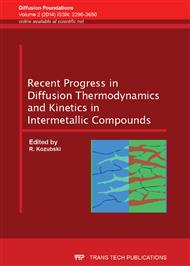[1]
F.M. d'Heurle, Nucleation of a new phase from the interaction of two adjacent phases: Some silicides, Journal of Materials Research. 3 (1988) 167-195.
DOI: 10.1557/jmr.1988.0167
Google Scholar
[2]
F.M. d'Heurle, P. Gas, J. Philibert, Diffusion-reaction: the ordered Cu3Au rule and its corollaries, Solid State Phenomena. 41 (1995) 93-102.
DOI: 10.4028/www.scientific.net/ssp.41.93
Google Scholar
[3]
J.M. Poate, K. N. Tu, J. W. Mayer, Thin films – Interdiffusion and Reactions, Wiley-Interscience, Berlin, (1978).
Google Scholar
[4]
F.J.J. van Loo, Multiphase diffusion in binary and ternary solid-state systems, Solid State Chemistry. 20 (1990) 47-99.
DOI: 10.1016/0079-6786(90)90007-3
Google Scholar
[5]
V.I. Dybkov, V.P. Dybkov, Growth kinetics of chemical compound layers, Cambridge Int Science Publishing, UK, (1998).
Google Scholar
[6]
K.P. Gurov, B.A. Kartashkin, Y.E. Ugaste, Mutual diffusion in multiphase metallic systems, Nauka, Moscow, (1981).
Google Scholar
[7]
Y.E. Geguzin, The Diffusion Zone, Nauka, Мoscow, (1979).
Google Scholar
[8]
A.M. Gusak, T.V. Zaporozhets, Yu.O. Lyashenkо et al., Diffusion-controlled Solid State Reactions: in Alloys, Thin-Films and Nanosystems, Wiley-VC, Berlin, (2010).
DOI: 10.1002/9783527631025.ch7
Google Scholar
[9]
A.M. Gusak, N.V. Storozhuk, Competition of K and F sinks during Void Formation, The Physics of Metals and Metallography. 114 (2013) 197-206.
DOI: 10.1134/s0031918x13030071
Google Scholar
[10]
A.G. Merzhanov, On critical conditions for thermal explosion of a hot spot, Combust. and Flame. 10 (1966 ) 341–348.
DOI: 10.1016/0010-2180(66)90041-1
Google Scholar
[11]
E. Ma, C.V. Thompson, L.A. Clevenger, K.N. Tu, Self-propagating Explosive Reactions in Al/Ni Thin Films, Appl. Phys. Lett. 57 (1990) 1262–1264.
DOI: 10.1063/1.103504
Google Scholar
[12]
L.A. Clevenger, C.V. Thompson, K.N. Tu, Explosive silicidation in nickel/amorphous-silicon multilayer thin films, J. Appl. Phys. 67 (1990) 2894–2898.
DOI: 10.1063/1.345429
Google Scholar
[13]
A.B. Mann, A.J. Gavens, M.E. Reiss, D. Van Heerden, G. Bao, T.P. Weihs, Modeling and characterizing the propagation velocity of exothermic reactions in multilayer foils, J. Appl. Phys. 82 (1997) 1178–1188.
DOI: 10.1063/1.365886
Google Scholar
[14]
S. Gennari, U.A. Tamburini, F. Maglia, G. Spinolo, Z.A. Munir, A new approach to the modeling of SHS reactions: combustion synthesis of transition metal aluminides, Acta Mater. 54 (2006) 2343–2351.
DOI: 10.1016/j.actamat.2006.01.009
Google Scholar
[15]
A.S. Rogachev, S.G. Vadchenko, F. Baras, O. Politano, S. Rouvimov, N.V. Sachkova, A.S. Mukasyan, Structure evolution and reaction mechanism in the Ni/Al reactive multilayer nanofoils, Acta Mater. 66 (2014) 86-96.
DOI: 10.1016/j.actamat.2013.11.045
Google Scholar
[16]
C. Wagner, The evaluation of data obtained with diffusion couples of binary single-phase and multiphase systems, Acta Metallurgica. 17 (1969) 99–107.
DOI: 10.1016/0001-6160(69)90131-x
Google Scholar
[17]
A.M. Gusak, A linear phase growth with non-equilibrium vacancies. Materials Science Forum, 155-156 (1994), 55-59.
DOI: 10.4028/www.scientific.net/msf.155-156.55
Google Scholar
[18]
G.B. Stephenson, Deformation during interdiffusion, Acta Mater. 36 (1988) 2663-2883.
Google Scholar


